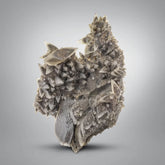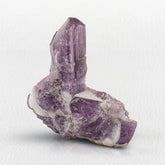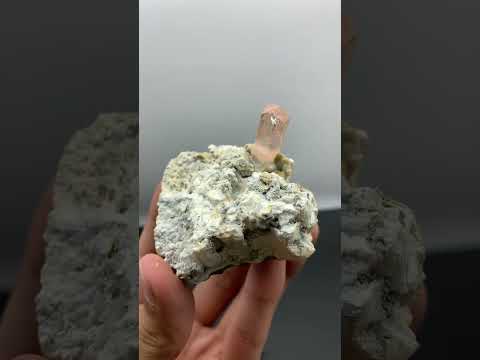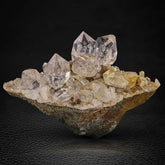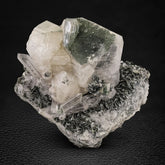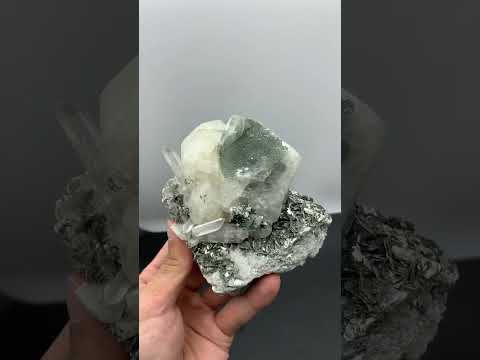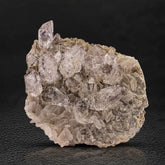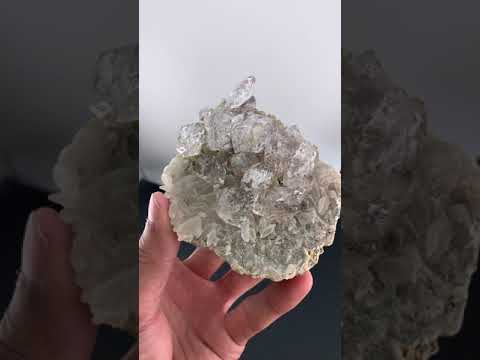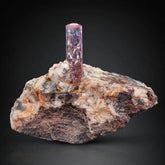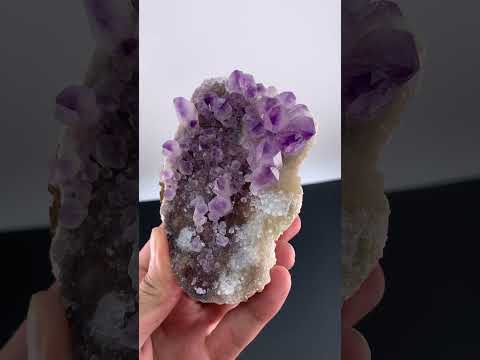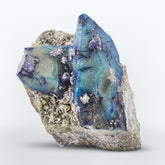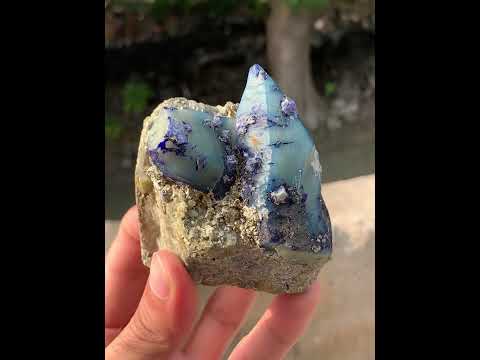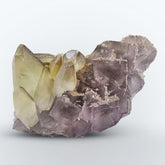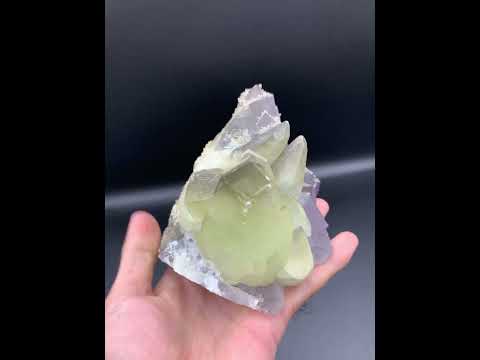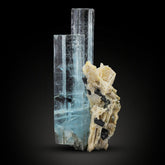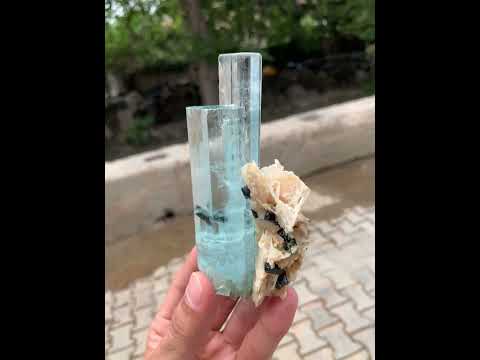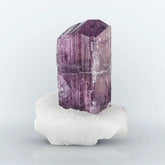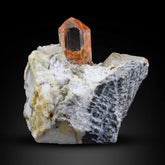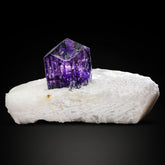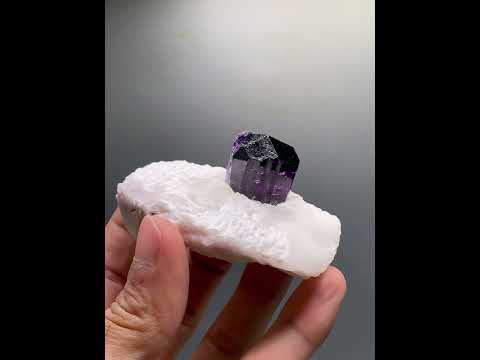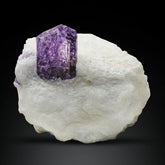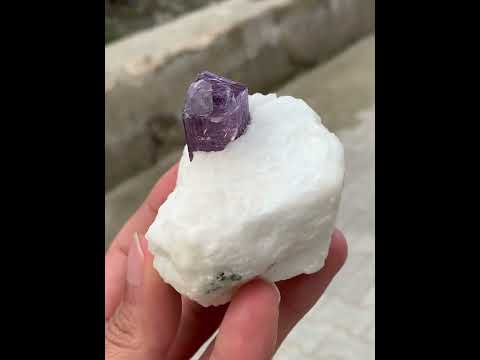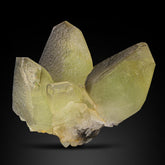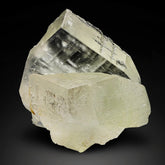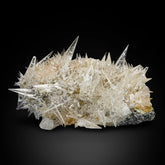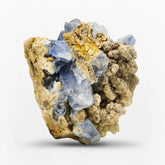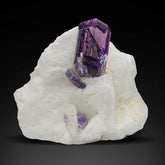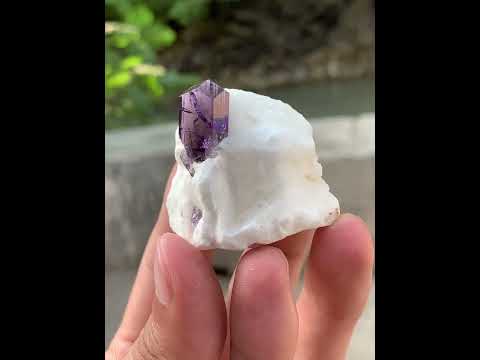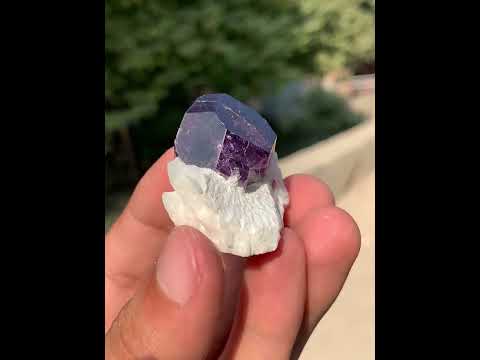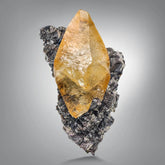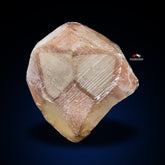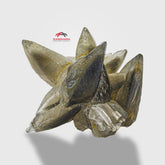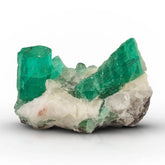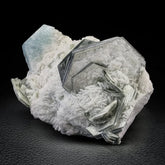Filter
28 results
30
- 10
- 15
- 20
- 25
- 30
- 50
Best selling
- Featured
- Best selling
- Alphabetically, A-Z
- Alphabetically, Z-A
- Price, low to high
- Price, high to low
- Date, old to new
- Date, new to old
Sort
Sort by:
- Featured
- Best selling
- Alphabetically, A-Z
- Alphabetically, Z-A
- Price, low to high
- Price, high to low
- Date, old to new
- Date, new to old
-
Sculptural and Artistic Aggregate of Twinned Calcite Cluster from Pakistan - Light-Yellow
This stunning sculptural aggregate features a mesmerizing twinned calcite crystal cluster sourced from Pakistan. The piece showcases intricate natural formations, with the twinning of the calcite crystals creating a captivating geometric interplay of angles and symmetry. The crystals exhibit a pearly luster and a...- $750.00
- $750.00
- Unit price
- / per
-
Light-Yellow
-
Free Standing Impressive Purple Scapolite Crystal on Calcite from Afghanistan - Purple
Vibrant purple Scapolite crystals on a backdrop of translucent Calcite create a stunning and captivating mineral specimen. The Scapolite, with its rich hue, commands immediate attention, drawing the eye with its intense purple coloration. The Scapolite crystals themselves may vary in size and shape, but...- $1,400.00
- $1,400.00
- Unit price
- / per
-
Purple
-
Vibrant Purple Scapolite Crystal on Calcite with Diopside from Afghanistan - Purple
This stunning specimen features a vibrant purple Scapolite crystal nestled against a backdrop of creamy white Calcite, creating a striking visual contrast. The Scapolite's vivid color and translucent clarity are complemented by the shimmering green accents of Diopside crystals, which are elegantly interspersed throughout...- $1,250.00
- $1,250.00
- Unit price
- / per
-
Purple
-
Pinkish-Peach Free Standing Topaz Crystal on Calcite from Pakistan - peachy_pink
The Standing Pink Topaz Crystal on Calcite Matrix from Pakistan is a stunning natural formation prized by mineral collectors and gem enthusiasts. The topaz crystal, known for its vibrant pink hue, stands prominently atop a calcite matrix, creating a striking visual contrast. The crystal...- $1,250.00
- $1,250.00
- Unit price
- / per
-
peachy_pink
-
Pointed Terminated Amethyst Diamond Quartz on Matrix from Pakistan - Light-Yellow
This stunning specimen features a beautiful display of Amethyst Quartz crystals resting elegantly on a matrix of Calcite. The Amethyst crystals, characterized by their deep violet to light lavender hues, exhibit sharp, well-defined terminations and a radiant translucence that allows light to pass through,...-
Light-Yellow
-
-
Isometric Focal Crystal of Calcite with Quartz on Mica from Pakistan - Light-Yellow
The isometric focal crystal of calcite with quartz on mica from Pakistan is a captivating mineral specimen that displays an intricate and harmonious combination of textures, colors, and forms. The calcite crystal, known for its rhombohedral shapes and clarity, exhibits an isometric structure, enhancing...- $350.00
- $350.00
- Unit price
- / per
-
Light-Yellow
-
Amethyst Diamond Yellow Quartz Crystals on Calcite from Pakistan - Light-Yellow
This stunning specimen features a beautiful display of Amethyst Quartz crystals resting elegantly on a matrix of Calcite. The Amethyst crystals, characterized by their deep violet to light lavender hues, exhibit sharp, well-defined terminations and a radiant translucence that allows light to pass through,...- $450.00
- $450.00
- Unit price
- / per
-
Light-Yellow
-
Free Standing Pink Topaz Crystal on Calcite Matrix from Pakistan - Purplish Pink
The Standing Pink Topaz Crystal on Calcite Matrix from Pakistan is a stunning natural formation prized by mineral collectors and gem enthusiasts. The topaz crystal, known for its vibrant pink hue, stands prominently atop a calcite matrix, creating a striking visual contrast. The crystal...-
Purplish Pink
-
-
Purple color Amethyst Quartz crystals on Calcite from Pakistan - Purplish Pink
This stunning specimen features a beautiful display of purple Amethyst Quartz crystals resting elegantly on a matrix of Calcite. The Amethyst crystals, characterized by their deep violet to light lavender hues, exhibit sharp, well-defined terminations and a radiant translucence that allows light to pass...-
Purplish Pink
-
-
Rare Bi color Afghanite crystals on Calcite with Pyrite from Afghanistan - Blue
This exquisite specimen features rare bi color Afghanite crystals elegantly perched on a matrix of creamy white Calcite, accented by shimmering flecks of Pyrite. The Afghanite crystals display a captivating combination of deep blue and a lighter sky-blue hue, creating a stunning contrast against...-
Blue
-
-
cluster of Calcite crystals on Purple color Fluorite from Pakistan - Purplish Pink
This captivating specimen features a stunning cluster of Calcite crystals elegantly perched atop a vibrant purple Fluorite matrix, sourced from the renowned mineral-rich regions of Pakistan. The Calcite crystals, with their translucent to milky-white appearance, create a striking contrast against the deep, rich hues...-
Purplish Pink
-
-
double terminated Aquamarine crystal with Calcite From Pakistan - LightBlue
This exquisite tie of double terminated Aquamarine with Calcite originates from the mineral-rich regions of Pakistan, known for its high-quality gemstone deposits. The Aquamarine, with its serene and soothing blue hues, evokes the tranquility of crystal clear waters, offering both visual appeal and metaphysical...-
LightBlue
-
-
vibrant Purple color Scapolite crystal on Calcite from Afghanistan - Purple
Purple Scapolite crystals on a backdrop of translucent Calcite create a stunning and captivating mineral specimen. The Scapolite, with its rich hue, commands immediate attention, drawing the eye with its intense purple coloration. The Scapolite crystals themselves may vary in size and shape, but...- $3,500.00
$1,220.00- $3,500.00
- Unit price
- / per
-
Purple
-
Topaz crystal on Calcite with vibrant color and clarity from Pakistan - Brown
Nestled within a bed of pristine white calcite, this exquisite topaz crystal from Pakistan captivates with its vibrant color and unparalleled clarity. The topaz, renowned for its remarkable range of hues, showcases a mesmerizing blend of vibrant tones, radiating warmth and brilliance. Its facets...- $6,500.00
- $6,500.00
- Unit price
- / per
-
Brown
-
Purple Scapolite crystal on creamy white Calcite from Afghanistan - Purple
Purple Scapolite crystals on a backdrop of translucent Calcite create a stunning and captivating mineral specimen. The Scapolite, with its rich hue, commands immediate attention, drawing the eye with its intense purple coloration. The Scapolite crystals themselves may vary in size and shape, but...- $1,800.00
$1,220.00- $1,800.00
- Unit price
- / per
-
Purple
-
Purple color Scapolite crystal on creamy white Calcite from Afghanistan - Purple
Vibrant purple Scapolite crystals on a backdrop of translucent Calcite create a stunning and captivating mineral specimen. The Scapolite, with its rich hue, commands immediate attention, drawing the eye with its intense purple coloration. The Scapolite crystals themselves may vary in size and shape, but...- $1,500.00
$1,220.00- $1,500.00
- Unit price
- / per
-
Purple
-
Purple Blue color Specimen of Fluorite with Calcite from Pakistan - Purple
This exquisite specimen of Fluorite with Calcite hails from the picturesque mines of Pakistan, showcasing a mesmerizing blend of purple and blue hues that captivate the beholder. The dominant presence of Fluorite manifests in varying shades, ranging from deep royal purples to ethereal blues,...-
Purple
-
-
Calcite rossetts crystal cluster on Aquamarine with Muscovite from Pakistan - LightBlue
In another enchanting tableau, Calcite rosettes cluster gracefully on a canvas of Aquamarine accompanied by Muscovite, forming a mesmerizing composition from the heart of Pakistan. The Calcite crystals, resembling delicate rosettes, create a captivating contrast with the soothing blue tones of the Aquamarine. Together,...-
LightBlue
-
-
trio of honey color Calcite Crystals with perfect termination from Pakistan - LightGold
In a captivating display of Earth's natural artistry, a trio of exquisite honey colored Calcite crystals takes center stage, each boasting a flawless termination that adds an enchanting touch to their overall allure. Hailing from the mineral-rich terrain of Pakistan, these crystals are a...- $220.00
- $220.00
- Unit price
- / per
-
LightGold
-
tabular gem vibrant purple color Scapolite crystal on Calcite from Afghanistan - Purple
Vibrant purple Scapolite crystals on a backdrop of translucent Calcite create a stunning and captivating mineral specimen. The Scapolite, with its rich hue, commands immediate attention, drawing the eye with its intense purple coloration. The Scapolite crystals themselves may vary in size and shape, but...-
Purple
-
-
honey color tabular twinned Calcite couple of crystals from Pakistan - White
Indulge in the captivating allure of this extraordinary Calcite crystal cluster on matrix from Pakistan, a true masterpiece of nature's artistry. This stunning formation boasts a harmonious blend of crystalline beauty and geological splendor. The Calcite crystals, intricately clustered on their mineral matrix, create...- $120.00
- $120.00
- Unit price
- / per
-
White
-
Artistic formation for Calcite crystal cluster on matrix from Pakistan - White
Indulge in the captivating allure of this extraordinary Calcite crystal cluster on matrix from Pakistan, a true masterpiece of nature's artistry. This stunning formation boasts a harmonious blend of crystalline beauty and geological splendor. The Calcite crystals, intricately clustered on their mineral matrix, create...- $220.00
- $220.00
- Unit price
- / per
-
White
-
Vibrant Blue color Celestine Crystals on Calcite from Afghanistan - Blue
Indulge in the celestial allure of these Vibrant Blue Celestine Crystals nestled on a bed of Calcite, sourced meticulously from the heart of Afghanistan. Each crystal is a masterpiece, boasting a captivating blue hue that evokes the essence of the expansive sky. The dynamic...- $850.00
$220.00- $850.00
- Unit price
- / per
-
Blue
-
Scapolite on Creamy White Calcite Matrix - Purple
The world of gemstones is a treasure trove of exquisite minerals, each with its unique charm and allure. Scapolite, a lesser-known gemstone, possesses a fascinating blend of beauty and mystique that has been gaining recognition among gem enthusiasts. At Gandhara Gems, a renowned name...-
Purple
-
-
Vibrant Purple Scapolite on Calcite from Afghanistan - Purple
Vibrant purple Scapolite crystals on a backdrop of translucent Calcite create a stunning and captivating mineral specimen. The Scapolite, with its rich hue, commands immediate attention, drawing the eye with its intense purple coloration. The Scapolite crystals themselves may vary in size and shape, but...-
Purple
-
-
Glamorous Honey Color Calcite 375 grams Crystal on Sphalerite Matrix from Afghanistan - Yellowish Golden
Presenting this attractive and aesthetic combination piece of honey Calcite focal crystal nicely positioned on Sphalerite matrix. The Calcite is double terminated showing great quality vitreous wet luster with marked transparency and saturated color. The dark brownish Sphalerite matrix nicely hosting the Calcite creating...- $1,250.00
$220.00- $1,250.00
- Unit price
- / per
-
Yellowish Golden
-
Interesting Alien Eyes Calcite New Find - Peach
Presenting this new find of interesting Alien eyes Calcite attractive visuals. The calcite has waxy luster with naturally modified terminations. It's very well crystalized all around with more like rounded terminations. The eyes formation is so interesting with highly cross sectional striations. Its a...-
Peach
-
-
Start Burst Cluster Of Calcite With Marcasite Inclusion - Green
Presenting this robust and lovely start shape cluster of elongated Calcite crystals with intersting Marcasite inclusion. It has magnificent waxy luster, pointed terminations with good translucency. It has perfect self standing display position, well crystalized all around with zero damage. It's an indeed beautiful...-
Green
-

